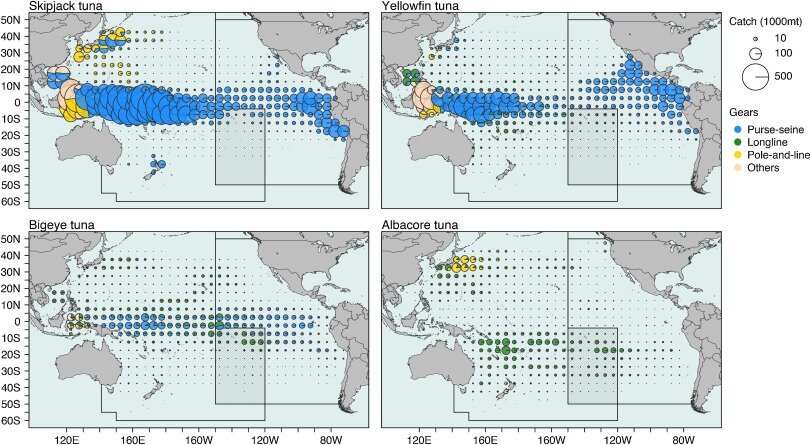I was an aspiring fisheries scientist back in the last century in Argentina, but the affair didn't lasted, you had to be very ingrained in the institution as to get a full-time job, and thanks to the union for at-sea workers, I was making the same money as sampling technician… so my work focused on sampling and data acquisition for my stock assessments colleges.
So I’m aware of the amazing amount of work they do, at the time we were just starting to work on modelling based on Virtual population analysis (VPA) as a cohort modelling technique. I soon established that I did not had the right “connections” to get into the fisheries institution and if I had to spend the rest of my time at sea, sampling for others, I rather go back fishing in warmer seas even if I loved the job and the little I helped in modelling.
Then, while I was fishing in the Pacific (92 to 95) the level and sophistication of modelling and the mathematical understanding required, took off exponentially… by the time I came to NZ it was a different world, and I knew I’ll never catch up… so I moved on. I’m not complaining at all, but I wonder sometimes how would have that B side sounded if I had followed that path.
In any case, the whole point of the story is that I have massive respect for the people that do this line of work, and I’m very lucky to know some of the best in the region… so when a paper on the topic for WCPO tuna come up… I stretch my brain and make the best effort to dive into them.
Fig. 1. Distribution and magnitude of total catches for skipjack, yellowfin, bigeye and albacore tunas in the Pacific Ocean between 2009–2018 by 5° square and fishing gear: purse-seine (blue), longline (green), pole-and-line (yellow) and others (pink).
In this particular (and massive) paper “Defining the stock structures of key commercial tunas in the Pacific Ocean: Current knowledge and main uncertainties” quite a few people from SPC I know and respect are among the authors and is crucial reading if you are a tuna head and what to know “where we are at” on the main 4 tuna species we catch.
I quote here the abstract and the conclusion. But as always: read the original (the discussion is excellent!)
Abstract
Tunas are the focus of significant fisheries in the Pacific Ocean, where landings of four species – skipjack tuna (Katsuwonus pelamis), yellowfin tuna (Thunnus albacares), bigeye tuna (Thunnus obesus) and albacore tuna (Thunnus alalunga) – constitute approximately 70 % of the global tuna catch. Stock assessments for skipjack, yellowfin and bigeye tunas in the Pacific Ocean currently assume eastern and western stocks. For albacore tuna, separate North Pacific Ocean and South Pacific Ocean stocks are currently assumed. In each case, these geographic definitions reflect the historical development of fisheries management across the Pacific rather than biological considerations.
There is widespread agreement that uncertainties surrounding the stock structures of these four tuna species could have important impacts on the population dynamics models used to assess their status and inform management options. Knowledge of stock structure is also essential for improved modelling of the effects of climate change on tuna distribution and abundance and associated implications for fisheries.
This paper reviews current knowledge and understanding of the stock structures of skipjack, yellowfin, bigeye and South Pacific albacore tunas in the Pacific Ocean, by exploring available literature relating to their biology, movement and spatial dynamics. As a guide for future research in this area, we identify the main uncertainties in defining the stock structure of these four tunas in the Pacific, including i) spawning dynamics; ii) the degree of spawning area fidelity and localised residency; iii) the provenance of individuals in, and proportional contributions of self-replenishing populations to, fishery catches within the Pacific Ocean; iv) linkages with adjacent ‘stocks’; v) the effects of climate change on stock structure and proportional contributions of self-replenishing populations to fisheries; and vi) the implications of improved knowledge of tuna stock structure for stock assessment and climate change model assumptions and fisheries management. We also briefly propose some approaches that future studies could use to address these uncertainties.
Conclusions
Although current assessments of skipjack, yellowfin, bigeye and South Pacific albacore tunas within each of the WPCFC and IATTC Convention Areas typically assume that each species forms a single stock, several lines of evidence reviewed here identify the potential occurrence of multiple stocks of each species within the Pacific Ocean basin at varying spatial scales. To better define the stock structures of Pacific tunas, and the underlying mechanisms by which spatial structuring occurs, additional research is required into uncertainty needs to be reduced in understanding of spawning dynamics (including any potential fidelity to particular spawning areas), origins and mixing of post-juvenile assemblages, and the proportional contributions of spawning units to mixed fisheries assemblages.
More powerful and cost effective genetic and genomic tools, in particular NGS approaches and modern molecular markers such as SNPs, combined with complementary approaches based on otolith chemistry and parasites and well-designed electronic tagging experiments, provide a promising way forward for testing specific hypotheses regarding uncertainties around the presence of self-replenishing populations and their contributions to harvested assemblages. It is recommended that management strategy simulations and climate modelling, based on various hypothetical scenarios of stock structure, be thoroughly evaluated for each species to determine how an improved understanding of stock structure would influence the management of tuna stocks and implementation of adaptations to reduce the impacts of climate-driven redistribution of tuna species on island economies.

